Tuesday June 18th, Hearing 37
“I saw with my own eyes and felt with my own body all the pain that the army caused”
Tiburcio Utuy (✝)
On the 37th day of hearings, the Public Prosecutor’s Office presented four previews of evidence from survivors, whose testimonies were recorded on July 20 and 21, 2010. The defense counsel requested that Maria Caba’s testimony not be heard, since a medical document justifying her absence was not presented. The Public Prosecutor’s Office commented that Ms. María is 95 years old and bedridden, therefore she is unable to attend court.
For its part, the court reaffirmed that it had already resolved this issue previously, in the hearing of April 9, 2024, indicating that it is necessary to hear the testimonies either in person or reproduce them on CD. Therefore, the first testimony was heard before members of the AJR of the Ixil region and Ixil Ancestral Authorities, international and national organizations and the press.
María Caba Caba
María Caba Caba was born in the community of Santa Ana, municipality of Chajul, but lived in Ilom at the time of the events, along with her husband and three children. Mrs. María was 82 years old at the time of her statement:
“At the time of the war they killed my husband in Ilom village, on January 15. The soldiers killed my husband, I was there when it happened. We were sleeping and at about 5 o’clock in the morning the army came by. They burned my house and then my neighbor’s house. My husband died there, I never saw him again. I was very scared, I thought they might kill me too.” Mrs. Maria said that two of her children were also killed.
Mrs. María said that she recognized the soldiers because they were dressed in camouflage and that she fled to the mountains with her youngest son for 4 years: “I was in the mountains, without food, without clothes, without anything, only malanga and herbs we ate with my son. The patrols were following us as well as the army, I ran with my son”. Mrs. Maria says that after the refuge, she returned to Ilom and found her house and belongings burned.
María Díaz Lainez (✝)
Mrs. María Díaz said that on January 15, the army arrived in the community around five o’clock in the morning and went to their houses to pick them up. They took the villagers to the village market. They separated the women in a building and the men, including her husband, were taken to the church and killed. After the massacre, the soldiers had them buried in a mass grave.
As soon as they opened the door where Mrs. Maria and the other women were, she says that she was very afraid and so she fled to the mountain, where three of her children died and Mrs. Maria had to bury them in a hole.
Mrs. María stayed in the mountains for five years, feeding on grass and malanga. The witness recalled that she identified the soldiers because they were dressed in camouflage and came from Amajachel, where there was a military detachment.
Bernal Asicona (✝)
In the reproduction of the testimony of the witness Bernal Asicona, the witness mentioned that he was 72 years old and was born in the village of Ilom, Chajul. The witness recounted that on January 15th, 1982, elements of the army arrived in his community for the first time and took 6 community members, whom they never saw again.
On March 23rd, 1982, the soldiers returned and took men and women to the plaza, locked the men in the church and killed those who were on a list in the school, taking them out two by two: “If we were not on the list, they put us in a butcher shop and those who were on the list, they killed them two by two. The butcher shop where they had us locked up was surrounded by soldiers.
After this, they forced the men to dig three pits to bury the victims. The soldiers went to where the women were locked up and forced them to serve them lunch, “because we are already hungry,” said the soldiers. When they finished digging the holes, the soldiers gave them five minutes to leave the community and said they were going to start burning their houses.
The witness responded that he did not remember the names of all the women who were forced to serve the soldiers, but that the witnesses María Caba Caba and María Díaz Lainez were in that group.
The witness assured that it was the army that perpetrated the massacre because he recognized their clothing, he said that they were in camouflaged uniform and that the guerrillas never came to his community. After the massacre, the witness took refuge in Finca La Perla where they harvested coffee without pay, “we worked so that they would give us a place to sleep.” It was not until 1983 that he was able to return to Ilom, although he points out that “there was nothing left when we arrived” and that they were forced to join the Civil Self-Defense Patrols (PAC’s).
Tiburcio Utuy (✝)
Mr. Tiburcio said that on February 16, 1982, he saw the army approaching, so he alerted the community and moved to a safe place, from where he could see how the army surrounded the house of a woman and macheted her head. He was also able to observe how another woman in the community who was pregnant, had her belly cut out, the baby taken out and crushed. After leaving they burned the house, with all the people inside, “only ashes were left” he said. He added that 20 people were also killed that day, including the baby and the two women.
He recounted the land razed to the ground after the army entered: “The army burned cars, sheep, dogs, everything, everything, the community was completely razed to the ground, the fruit trees and people’s crops were cut down. We could no longer live there, because the army kept circling there.”
Mr. Tiburcio said that after the massacre he and other survivors preferred to hide in the mountains than die at the hands of the army. He stated that when they were in the mountains the army bombed and machine-gunned the areas where they thought they were hiding. He explained that after organizing with the people who were in hiding they made the decision to leave in search of a place where they could hide.
One afternoon in the mountain, two warplanes and three helicopters arrived, dropping bombs on the mountain, close to where the people were taking refuge, while the helicopter shot with the machine gun: “That sacred mountain saved our lives” commented Mr. Tiburcio.
He recounted how the army redoubled its onslaught and surrounded them militarily in the mountains for 6 months, with the objective of capturing and killing them: “Many people died, more than 300 children died, and more than 100 adults, from hunger, thirst, measles, whooping cough”.
In his account he commented how he was captured (while in the mountains) by elements of the army on an occasion when he went out to look for food. He indicated that when they interrogated him he explained that he did not know anything and that he could not help them in any way, they also demanded that he take them to where the villagers were hiding. Because he did not help them, they tortured him. The witness said that they tied him up, covered his mouth and eyes and tortured him by burning him with fire. After this, Mr. Tiburcio was taken to various military detachments and the torture was repeated in Sacapulas where he was interrogated by former President Otto Pérez Molina. He was then taken to the military base in Quiché where he was tortured for 12 days. He indicated that finally he was transferred to Playa Grande where he remained for 5 months.
When asked by the Public Prosecutor’s Office what he was asking the court, Mr. Tiburcio responded:
“I saw it with my own eyes and felt with my own body all the pain caused by the army. We are demanding justice, that those responsible for the thousands of people who died be punished. I ask that you as judges, as authorities, seek to enforce the laws.”
Wednesday June 19th, Hearing 38
Juan Carlos Estrada Gamboa, expert in forensic anthropology, was presented to ratify his expert report on the exhumation of bodies from the massacre of March 23, 1982, in the village of Ilom, San Gaspar Chajul, Quiché.
Mass graves were found near the community cemetery. The remains had bullet holes and in grave number 3, 10 bodies were found piled up without any mortuary process, that is, they were not in boxes or wrapped. However, they did have remains of their clothes and personal objects. The expert explained that in general, at that time the people of the community had few changes of clothes, a situation that made it easier for the relatives to recognize them.
After the expert’s statement, the audios of witnesses José Itzep and Juan Cruz, which were recorded on July 22, 2010, were played as a preview of the evidence.
Testimony of José Itzep
Mr. José said that since 1980 the army arrived to gather only the women of his village, because all the men were working. But it was in 1981 when the threats and interrogations began. He explained that he worked in Chajul and came across the soldiers on his way back to his village. He said that on one occasion they beat him for not having information about the guerrillas and also extorted him to return his ID card.
Mr. José testified that in January 1982, the first massacre he had heard about happened 1.5 km from where he lived. As a result of this, in his community they organized themselves to protect themselves, they agreed to take turns to watch and warn when the army was coming to the community.
Mr. José said that on February 16, 1982, the army killed 21 people in his village Xix, including a baby still in its mother’s womb. He added that he helped bury the murdered people. In addition, they burned their houses, crops, home ownership documents and killed their animals. Mr. José testified that he spent almost 3 years in the mountains and that the few crops they managed to grow there were cut down or burned by the army.
Testimony of Juan Cruz
Afterwards, the testimony of Mr. Juan Cruz was heard, who told how on January 22nd, 1982, the army killed his wife and two children. They buried his family in a hole before fleeing. He said that about 8 people died, at the hands of the army whom he could identify by their uniforms and military trucks coming from Finca San José.
Thursday June 20th, Hearing 39
On this day, the testimonies of Mrs. María Gómez and Mr. Sebastián Saquij Córdoba were reproduced. On this day, a delegation of Nobel Peace Prize laureates, among them Rigoberta Menchú and the American Jody Williams, who together with the rest of the delegation showed their support for the survivors of the Ixil people, was present at the Courthouse.
Testimony of María Gómez
In her testimony, Mrs. Gómez related that she witnessed how elements of the Guatemalan army arrived in the village of Jauventau on August 25 to burn the villagers’ houses and crops, kill their animals and murder several people. She said she did not remember how many people died that day, but that the people who were killed in her community could not be buried because the soldiers threw them in the river or in pits.
Mrs. María said that on that day the soldiers arrived at her house around 11pm asking for her son Sebastián and that when they found him they took him out, tied him up and beat him. She added that after that the soldiers took him away, but she never knew why. She explained that she was also beaten and that they burned her house and clothes and left her with nothing. She said she looked in several places for her son, but never found him. She said she remembered that on that day there were 60 soldiers who came to the community and that they abused and killed a girl named Katarina. She identified the soldiers by their brown-colored clothing.
Mrs. María testified that she managed to escape from the soldiers and that she took refuge in the mountain for 1 month, accompanied by some neighbors and some of her children. She pointed out that among the people who were in the mountain there were girls, boys, old people, women and men, who fed on herbs and regularly on malanga.
Mrs. María said that during the time she was in the mountains, the army harassed them by throwing bombs at them and burning what they managed to plant. She said that she was able to return to her community, but having lost everything she had to look for another place to live. She explained that because of everything she suffered he suffers from fear and pain in her legs and that at times she believes that everything will happen again.
Testimony of Sebastián Saquil
In the audio of Mr. Sebastián Saquij, recorded when he was 67 years old in 2010, he said that elements of the army came to his community and forced them to go with them to the detachment located in the municipality of San Juan Cotzal, when they arrived at the detachment they captured them and 4 of the men who accompanied him were killed by the soldiers, including one of his relatives. Mr. Sebastián stated that the bodies of the murdered people are in a grave located outside the detachment and that all of this happened in 1982.
Mr. Sebastián also witnessed the massacre of the Chisis village, although he could not give an exact number of soldiers who attacked the community, but that there were many and that perhaps 400 people were killed. He added that the houses in the community were also burned and that although they managed to escape to the mountains he could not return because the army returned to the village every 3 days to look for survivors. He said that all the villagers know that it was Gaspar Pérez who gave the army a list of names of those he accused of helping the guerrillas.
He said that during the time he was in the mountains the soldiers chased them and bombed the areas where they thought they were hiding. He added that there were girls, boys, elderly people, men and women. He said that at the time many of the survivors tried to find the family members that the army had taken away, but they never found them.
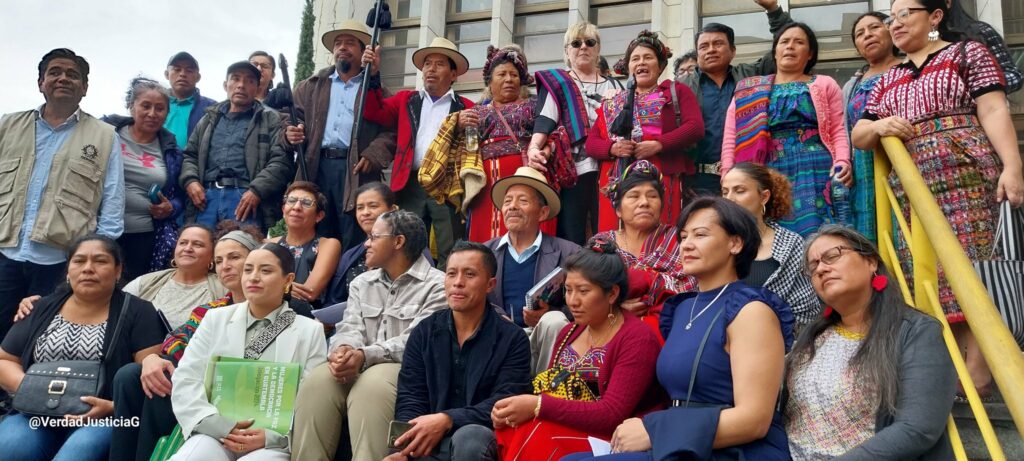
Men and women survivors of the genocide in the Ixil region outside the courthouse, accompanied by Ixil ancestral authorities, members of social organizations and the delegation of women Nobel Peace Prize laureates. Photo: Verdad y Justicia

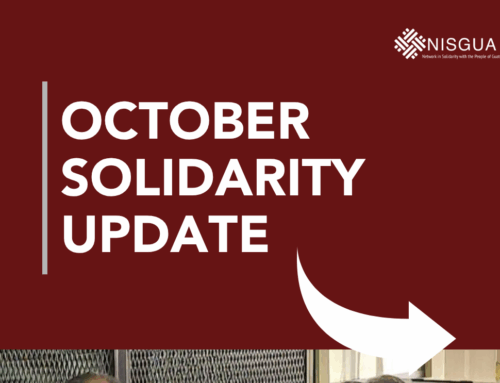
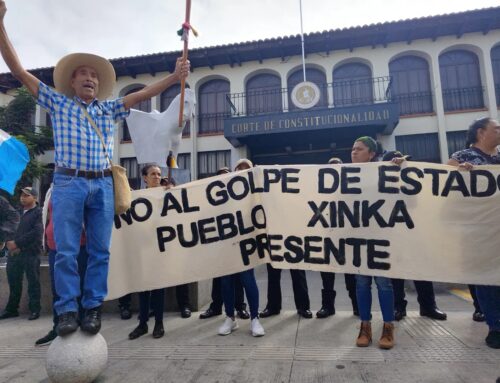
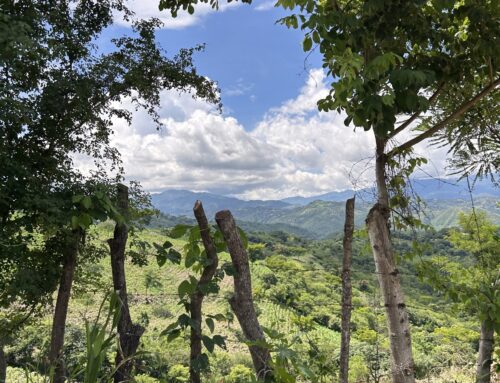
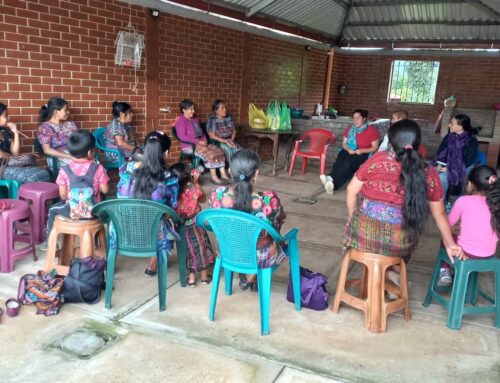
Leave A Comment